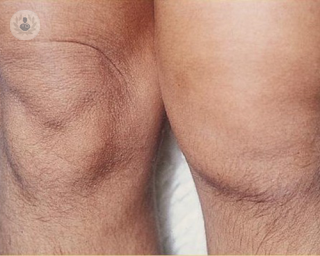Partial knee replacement
Mr Madhusudhan Raj Nannaparaju - Orthopaedic surgery
Created on: 06-25-2015
Updated on: 09-06-2023
Edited by: Aoife Maguire
What is a partial knee replacement?
A partial knee replacement is a surgical procedure where, unlike in a full knee replacement, only the damaged or injured part of the knee is removed and replaced. It generally causes less pain and allows the patient a faster recovery, due to the fact that it is a less invasive operation and preserves more of the natural joint.

What conditions does a partial knee replacement treat?
Partial knee replacement is generally used to treat patients with knee arthritis, in particular those who have not responded to treatment.
A partial knee replacement is typically used to treat conditions that involve severe damage or arthritis in only one of these compartments while leaving the other compartments relatively healthy. The most common conditions that can be treated with a partial knee replacement include:
Medial compartment osteoarthritis: this is the most common reason for a partial knee replacement. It occurs when the cartilage on the inner part of the knee joint wears away, causing pain, stiffness, and limited mobility.
Lateral compartment osteoarthritis: similar to medial compartment osteoarthritis, this condition affects the outer part of the knee joint.
Patellofemoral osteoarthritis: when the cartilage in the front of the knee joint (between the patella and femur) deteriorates, it can lead to pain and difficulty with activities like climbing stairs or kneeling.
Traumatic knee injuries: some traumatic injuries, such as fractures or ligament tears, can cause isolated damage to one compartment of the knee joint. In certain cases, a partial knee replacement may be considered.
What happens during partial replacement surgery?
Before the procedure takes place, the surgeon will perform a comprehensive patient evaluation, which will include a medical history review, physical examination, and diagnostic imaging (X-rays, MRI) to determine if the damage is confined to one knee compartment. They will administer anaesthesia, typically spinal or epidural anaesthesia which will numb the lower body while keeping the patient awake.
A small incision is then in total knee replacement is made, focused on the affected compartment. The incision's size depends on the surgical approach and the patient's needs.
Unlike with total knee replacement, only the damaged cartilage and bone in the affected compartment are removed, preserving healthy tissue in the rest of the knee. The surgeon attaches the artificial components of the knee implant, usually consisting of a metal component for the femur, a metal component for the tibia, and a plastic spacer to recreate the joint surface in the affected compartment.
After implant placement, the incision is closed with sutures or staples and sterile dressings are applied. When the procedure is complete, patients will be monitored in the recovery room as the anaesthesia effects wear off. The majority of patients start walking with assistance within a day.
Postoperative care
After undergoing partial knee replacement, patients must undertake rehabilitation and physical therapy, focusing on restoring strength and mobility to the affected knee compartment.
It is crucial for the patient to manage postoperative pain is essential. Medications prescribed by your surgeon will help control pain. Take them as directed and communicate any concerns about pain management with your healthcare team.
It is also essential to adhere to any activity restrictions or precautions outlined by your surgeon. Avoid high-impact activities or strenuous exercises until cleared by your medical team.
What are the advantages of partial knee replacement over total knee replacement?
Partial knee replacement offers quicker recovery and less disruption to healthy knee tissue compared to total knee replacement. It's an option when knee damage is isolated, typically in cases of medial or lateral compartment osteoarthritis or patellofemoral osteoarthritis. Successful surgery can alleviate pain and improve function in the affected knee compartment, allowing patients to return to a more active lifestyle.
How do I know if I am a candidate for knee replacement surgery?
It is important to note that not all patients with knee pain or arthritis are candidates for partial knee replacement surgery. The decision to undergo this procedure is based on various factors, including the extent of damage, the patient's overall health, and the surgeon's evaluation. If multiple compartments of the knee are affected or if there are other factors that make partial knee replacement less suitable, a total knee replacement may be recommended instead.
In order to be eligible for partial knee replacement surgery, the patient must have a functioning knee with intact internal ligaments, and the rest of the knee must be in reasonable condition.
Patients considering knee surgery should consult with an orthopaedic surgeon who can assess their specific condition and recommend the most appropriate treatment option, whether it's a partial or total knee replacement or other non-surgical treatments.

















